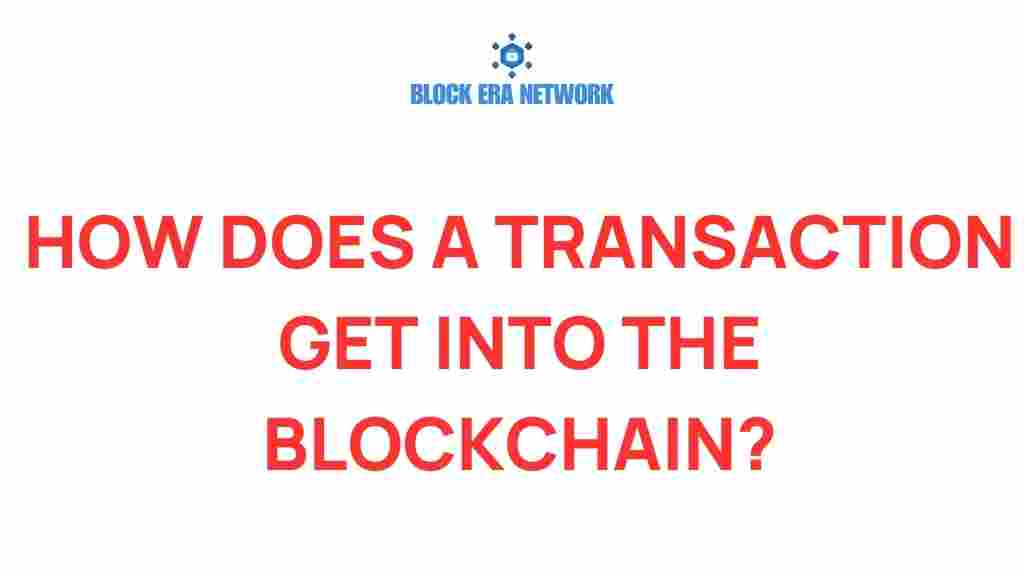Unveiling the Mystery: How Does a Transaction Get into the Blockchain?
The world of blockchain technology can seem complex and enigmatic to many. At its core, blockchain is a decentralized digital ledger that records transactions in a secure, transparent, and tamper-proof manner. But how exactly does a transaction get into this blockchain? This article will guide you through the transaction process, exploring the various components such as the consensus mechanism, cryptography, and the role of the decentralized network. By the end, you will have a clear understanding of how data integrity is maintained and how each transaction is validated in this innovative technology.
The Basics of Blockchain Technology
Before diving into the transaction process, let’s briefly outline what blockchain is and its fundamental characteristics:
- Decentralized Network: Unlike traditional databases that are controlled by a central authority, blockchain operates on a network of computers, known as nodes, that work together to maintain the integrity of the data.
- Digital Ledger: Blockchain acts as a digital ledger, where every transaction is recorded in a block and linked to the previous block, creating a chain of blocks.
- Cryptography: Security is paramount in blockchain technology. Transactions are secured using cryptographic techniques, ensuring that data cannot be altered or tampered with.
- Consensus Mechanism: A method by which all nodes in the network agree on the validity of transactions, thereby maintaining the integrity of the blockchain.
The Transaction Process: Step-by-Step
Now, let’s delve into the step-by-step transaction process that a transaction undergoes to be added to the blockchain.
Step 1: Initiating a Transaction
The transaction process begins when an individual or entity initiates a transaction. This could be a transfer of cryptocurrency, a smart contract execution, or any other data exchange. The transaction is created and includes essential details such as:
- The sender’s wallet address
- The recipient’s wallet address
- The amount of currency or data being transferred
- A timestamp
Step 2: Broadcasting the Transaction
Once the transaction is created, it is broadcasted to the network of nodes. Each node receives the transaction data, which is stored in a memory pool known as the mempool. Here, it awaits validation.
Step 3: Validation of the Transaction
Validation is a crucial step in ensuring the transaction’s legitimacy. This is where the consensus mechanism comes into play. Depending on the type of blockchain, various consensus mechanisms such as Proof of Work (PoW) or Proof of Stake (PoS) may be used. Here’s how validation typically works:
- Nodes check the transaction against the blockchain’s existing records to ensure that the sender has sufficient balance.
- Transactions are grouped into a block once they are deemed valid.
- The block is then broadcasted to the network for further consensus.
Step 4: Consensus Mechanism in Action
The consensus mechanism is critical for achieving agreement among nodes about the validity of transactions. Here’s a brief overview of how this works:
- Proof of Work (PoW): Miners solve complex mathematical problems to validate transactions and create new blocks. This process requires significant computational power.
- Proof of Stake (PoS): Validators are chosen to create new blocks based on the number of coins they hold and are willing to “stake” as collateral.
Once consensus is reached, the new block is added to the blockchain, and the transaction is considered confirmed.
Step 5: Adding the Transaction to the Blockchain
The final step is the addition of the validated block, which contains the transaction, to the existing blockchain. This process ensures that:
- The transaction is time-stamped and permanently recorded.
- The blockchain remains immutable, meaning that once a transaction is recorded, it cannot be altered or deleted.
- All nodes in the network update their copies of the blockchain to reflect the new addition.
Understanding Data Integrity in Blockchain
Data integrity is one of the core advantages of blockchain technology. Here’s how it is achieved:
- Cryptographic Hash Functions: Each block contains a unique hash that connects it to the previous block. Altering any data in a block changes its hash, making tampering easily detectable.
- Decentralization: Since the blockchain is distributed across many nodes, no single entity controls the entire network, making it difficult to corrupt.
- Consensus Mechanisms: They provide a way for nodes to agree on the state of the blockchain, ensuring that only legitimate transactions are recorded.
Troubleshooting Common Issues in Transactions
While the transaction process is robust, issues can occasionally arise. Here are some common problems and troubleshooting tips:
- Transaction Not Confirmed: If your transaction is taking too long to confirm, it could be due to low transaction fees. Consider increasing the fee for faster processing.
- Double Spending: This occurs when someone tries to spend the same cryptocurrency twice. The consensus mechanism prevents this by ensuring that only one transaction is valid.
- Lost Transactions: Sometimes transactions may not appear on the blockchain. This could be due to network congestion or improper broadcasting. Always check the transaction ID using a block explorer.
Conclusion
In conclusion, understanding how a transaction gets into the blockchain is essential for anyone looking to navigate the world of digital finance and decentralized applications. The intricate transaction process, which includes broadcasting, validation, and consensus mechanisms, ensures that every transaction is secure, transparent, and immutable. By leveraging cryptography and maintaining a decentralized network, blockchain technology upholds data integrity and fosters trust in digital transactions.
As blockchain continues to evolve, staying informed about its processes and challenges will empower users and developers alike. For more in-depth information, you can explore resources on blockchain technology and its applications. Embrace the digital revolution and unlock the potential of blockchain!
This article is in the category Blockchain Basics and created by Block Era Network Team
